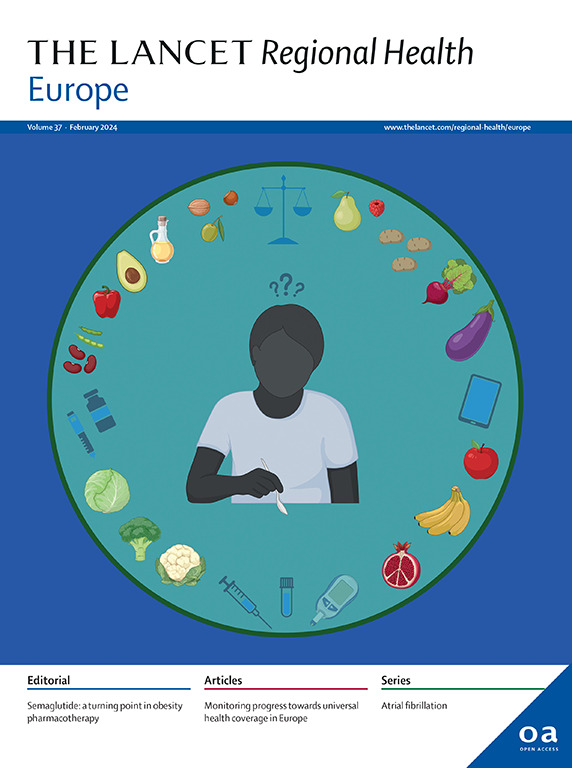Long–term effects of gastric bypass and sleeve gastrectomy in type 2 diabetes: a matched retrospective cohort study from Sweden
IF 13
Q1 HEALTH CARE SCIENCES & SERVICES
引用次数: 0
Abstract
Background
Long-term data on the efficacy and safety of Roux-en-Y gastric bypass (RYGB) or sleeve gastrectomy (SG) in people with type 2 diabetes mellitus (T2DM) are still limited. Using a matched cohort design, we aimed to evaluate the long-term effects of RYGB and SG on individuals with T2DM, focussing on obesity- and surgery-related outcomes over a follow-up period of up to 14 years.
Methods
A nationwide, matched, longitudinal study was conducted using data from the Swedish National Diabetes Register (NDR) and the Swedish Obesity Surgery Registry (SOReg). Between 2007 and 2020, all individuals with T2DM who underwent primary surgery (RYGB = 7294 and SG = 1105) were identified through SOReg and matched by age, sex, and BMI to a control group of individuals with T2DM from NDR who had not undergone surgery (n = 8399). Data on all-cause mortality and obesity- and surgery-related outcomes after RYGB and SG were retrieved from national registers with almost complete coverage. Risks were expressed as incidence rates per 10,000 person-years and analysed using adjusted Cox regression models, which included duration of diabetes, yielding adjusted hazard ratios (HR) with 95% confidence intervals (CI).
Findings
During follow-up, the percentage total weight loss and reductions in HbA1c levels were significantly greater after RYGB and SG than in unexposed individuals (%TWL: RYGB 23·2 vs. 3·6 and SG 17·1 vs. 3·1 at two years, smd > 0·1) and (mean HbA1c: RYGB 46 (SD 14) vs. 58 (SD 17) and SG 46 (SD 13) vs. 55 (SD 15) at two years, smd > 0·1). RYGB was associated with sustainable reductions in all-cause mortality (adjusted HR of 0·62 (95% CI [0·51–0·71])) and obesity-related comorbidities, with risks as much as 45% lower compared to unexposed individuals (p < 0·001). However, individuals after RYGB face as much as a twofold increased risk of malabsorption and micronutrient deficiency (adjusted HR of 2·00 (95% CI [1·76–2·28])) and alcohol use disorder (adjusted HR of 2·82 (95% CI [2·37–3·36])), p < 0·001. The risk of other psychiatric disorders, such as depression (adjusted HR of 1·28 (95% CI [1·14–1·43])), and surgical complications, such as bowel obstruction (adjusted HR of 3·96 (95% CI [3·15–4·98])), was also higher after RYGB (p < 0·001). In contrast, the SG cohort showed no significant effects on obesity-related conditions and risk of surgical complications, despite similar weight reduction in both surgery groups.
Interpretation
The study highlights the advantages and limitations of RYGB and SG, providing insights to guide an individualised approach. The limited efficacy of SG in lowering obesity-related disease risks should be a key consideration when selecting individuals with T2DM for surgery.
Funding
A grant from the Swedish state under the agreement with the county councils.
胃旁路和袖式胃切除术对2型糖尿病的长期影响:一项来自瑞典的匹配回顾性队列研究
背景:Roux-en-Y胃旁路(RYGB)或袖式胃切除术(SG)治疗2型糖尿病(T2DM)的有效性和安全性的长期数据仍然有限。采用匹配队列设计,我们旨在评估RYGB和SG对T2DM患者的长期影响,重点关注肥胖和手术相关的随访结果,随访期长达14年。方法采用瑞典国家糖尿病登记(NDR)和瑞典肥胖手术登记(SOReg)的数据进行全国性、匹配的纵向研究。2007年至2020年间,通过SOReg识别所有接受原发性手术的T2DM患者(RYGB = 7294, SG = 1105),并按年龄、性别和BMI与未接受手术的NDR T2DM患者对照组(n = 8399)进行匹配。RYGB和SG后的全因死亡率、肥胖和手术相关结果的数据从几乎完全覆盖的国家登记册中检索。风险以每10,000人年的发病率表示,并使用校正Cox回归模型(包括糖尿病持续时间)进行分析,得出校正风险比(HR), 95%置信区间(CI)。在随访期间,RYGB和SG后总体重减轻和HbA1c水平降低的百分比明显高于未暴露个体(两年后,百分比TWL: RYGB 23.2 vs. 3.6, SG 17.1 vs. 3.1, smd > 0.1)和(平均HbA1c: RYGB 46 (SD 14) vs. 58 (SD 17)和SG 46 (SD 13) vs. 55 (SD 15), smd > 0.1)。RYGB与全因死亡率(调整后的HR为0.62 (95% CI[0.51 - 0.71])和肥胖相关合共病的持续降低有关,与未暴露个体相比,风险降低45% (p < 0.001)。然而,RYGB后个体面临吸收不良和微量营养素缺乏的风险增加两倍(调整后的风险比为2.00 (95% CI[1.76 - 2.28]))和酒精使用障碍(调整后的风险比为2.82 (95% CI [2.37 - 3.36])), p < 0.001。其他精神疾病的风险,如抑郁症(调整HR为1.28 (95% CI[1.14 - 1·43])和手术并发症,如肠梗阻(调整HR为3.96 (95% CI[3.15 - 4.98])),在RYGB后也较高(p < 0.001)。相比之下,SG组对肥胖相关疾病和手术并发症的风险没有显着影响,尽管两个手术组的体重减轻程度相似。该研究强调了RYGB和SG的优点和局限性,为指导个性化方法提供了见解。在选择T2DM患者进行手术时,SG在降低肥胖相关疾病风险方面的有限疗效应该是一个关键考虑因素。根据与郡议会的协议,由瑞典政府提供的补助金。
本文章由计算机程序翻译,如有差异,请以英文原文为准。
求助全文
约1分钟内获得全文
求助全文
来源期刊

Lancet Regional Health-Europe
Multiple-
CiteScore
19.90
自引率
1.40%
发文量
260
审稿时长
9 weeks
期刊介绍:
The Lancet Regional Health – Europe, a gold open access journal, is part of The Lancet's global effort to promote healthcare quality and accessibility worldwide. It focuses on advancing clinical practice and health policy in the European region to enhance health outcomes. The journal publishes high-quality original research advocating changes in clinical practice and health policy. It also includes reviews, commentaries, and opinion pieces on regional health topics, such as infection and disease prevention, healthy aging, and reducing health disparities.
 求助内容:
求助内容: 应助结果提醒方式:
应助结果提醒方式:


